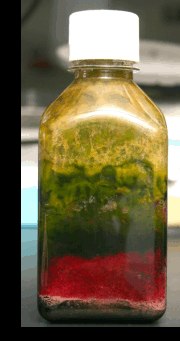
90% of the biomass on Earth is microscopic, so if we find
life elsewhere it’s likely to be small. But even microscopic
life can lead to big changes in a planet’s atmosphere,
forming vast communities that work together to survive.
 Microbial
colonies like this one can be found all over Earth. Microbes
in the top layers of the colony produce oxygen as a byproduct
of photosynthesis, just like plants. Other microbes throughout
the colony use oxygen for respiration. The layers visible
in this jar are each dominated by different kinds of microorganisms.
Together, they make up an entire ecosystem of producers and
consumers of organic matter.
Microbial
colonies like this one can be found all over Earth. Microbes
in the top layers of the colony produce oxygen as a byproduct
of photosynthesis, just like plants. Other microbes throughout
the colony use oxygen for respiration. The layers visible
in this jar are each dominated by different kinds of microorganisms.
Together, they make up an entire ecosystem of producers and
consumers of organic matter.
Bubbles of oxygen escape from the surface of the colony.
Over millions of years, bubbles like these created the oxygen
rich atmosphere that we breathe today.
You can make a community of microorganisms of your very
own. Winogradsky columns like these develop from microorganisms
that exist in mud almost anywhere you look. Winogradsky columns
are created from organic-rich mud plus light and a food source,
such as crumpled-up newspaper. Nature does the rest.
Inside a mature column, each layer is the address of a
specific type of microbe that lives off the waste products
of its neighbor and, in turn, gives off waste products that
sustain life in another layer.



